Our jasmine vine produced a fruit. We didn’t know they could do that.
Heck, we didn’t even know what kind of jasmine we have. It can be a little confusing, because are several vines called jasmine: Jasminum (Jasmine), Trachelospermum (Star Jasmine), and Stephanotis (Madagascar Jasmine or Bridal Veil). There is a Gardenia called Cape Jasmine, and I’m sure there are still other flowers sharing the name.
Our plant is Stephanotis, which produces clusters of sweet-scented white blossoms. It attracts hummingbirds, who feed from the flowers and perch on the vines to keep watch over their territory. And, we have learned, it occasionally produces a large inedible mango-shaped fruit.
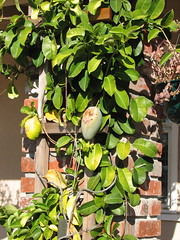
Our vines have been very healthy – they must like the climate here in the bay area. We don’t have to pay much attention to them. One day, we walked up to the house and noticed that there was a big green fruit on the vine. It was the same color and shape as the leaves, so maybe we can be excused for not seeing it until it was the size of an avocado.
We pulled out the ever handy Western Garden Book, and flipped to vines, where we figured out what plant we have. Unfortunately, there was just a brief paragraph on care and feeding, but no information on fruit. It didn’t even tell us that Stephanotis is usually propagated by cuttings.
This information from the Royal Horticultural Society helped clarify things. Other people have had this experience, too! Apparently the vines can produce fruit once every few years. This discussion from the University of British Columbia’s Botanical Centre gave some additional advice, saying that it is helpful to harvest the seeds before they go dormant if you want to try to grow them.
Since the vines tend not to flower while there is a fruit on the vine, and we like that the flowers draw the hummingbirds, we decided to pick the fruit and dissect it.
It is completely interesting inside. There is a thick fleshy outer layer. Inside that, the seeds are layered over a central core and each seed has a tuft of fuzz attached. The central part came out cleanly once the fleshy part was split open.
The layered seeds look like scales. And in the fuzz department, these babies put dandelions to shame! If we had let it mature on the vine, the fruit would have opened up and the seeds would have blown away.
Here’s a good overview of Stephanotis, and here’s a more in-depth article for further reading.




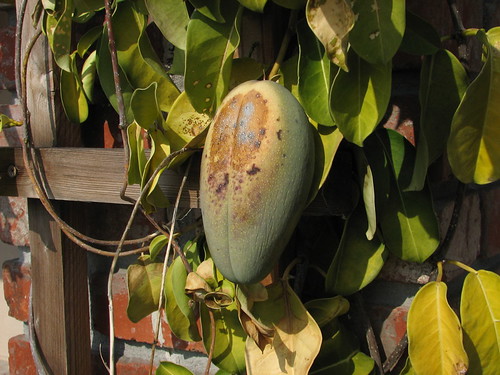
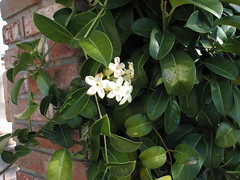

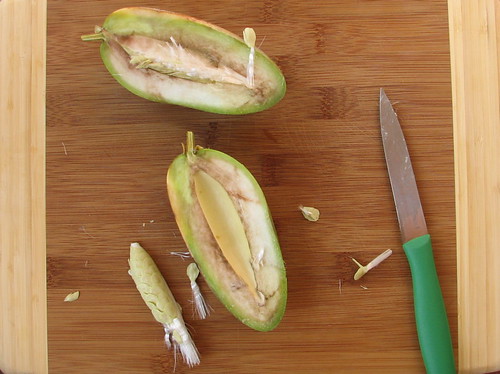
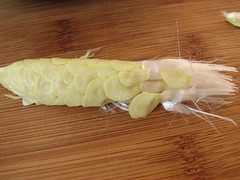
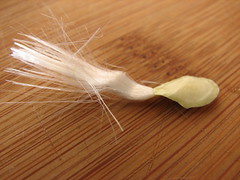
Are you sure it’s not a Pod People pod? Sure looks like one.
It’s possible. We haven’t gone to sleep since we found it– just in case.
—
Windell H. Oskay
drwho(at)evilmadscientist.com
http://www.evilmadscientist.com/
Im from Hawaii, and stephanotis grows like wildfire there. We use ’em in leis and what not. They smell AWESOME! You’re lucky to have one…I’m in Washington right now and I would kill to smell a little bit of home right now!
Thanks to the person who posted this comment on the fruit of the Madagascar Jasmine, I now know what it is! I’ve had this plant 3 years now (in a pot) and it’s the first time its produced a fruit. I too did not notice it until it was the size of an avocado, at frist I thought I was seeing things…I had no idea this plant did this. Thanks for posting your comment, Roberta Southern CA
I have one Jasmine this summer and its fruit came out at beginning of this winter. The fruit appeared orange&brown color. I did a litter search. Jasmine flower smells fragrant. The fruit of Jasmine is rarely seen. Take off the fruit when its in the orange&brown color, and put if in warm water to make it soft. Shuck off the seedcase and you will get the jasmin seed. put the jasmine seed into soil pot and the burgeon will come out one month later. It will need three years to bloom. Hope it will help.
Did you eat the fruit and did it taste how it smells? and does it smell like jasmine? I love jasmin tea!
No, we didn’t eat it, as they aren’t edible. The jasmine that is used for tea is jasminum sambac, not madagascar jasmine (stephanotis). Jasmine (jasminum) has a purple-black berry which is toxic.
Thanks for posting that! Our Madagascar Jasmine plant is growing a fruit too!
1. Here’s a photo of the fruit.
2. And one of the flowers.
3. And the plant itself.
My mom found it and wanted to eat it thinking it’s going to be sweet, but I persuaded her to let it hang out for a little bit while I did some research. Now I know from the looks of it, it doesn’t seem to have any flesh and is just a seed pod. Do you think I should pick it or let it sit there for a bit? Right now it is the size of chicken egg.
Our plant did not do very well after producing the fruit– it didn’t produce any more flowers for another year and half of the vines died. If you like your plant the way it is, I’d suggest removing the fruit ASAP.
—
Windell H. Oskay
drwho(at)evilmadscientist.com
http://www.evilmadscientist.com/
I have a small madagascar plant at home indoors. I have had it for many years. Three weeks ago I noticed a small fruit on it as big as a cherry and it is now bigger than an apple. It grows fast and it is amazing that this small plant can carry it. This is happening in Sweden. Contact me through nilu_thunell@hotmail.com if you want to know more.
Please do not eat the fruit! To anyone that doesnt know, this plant is in the same family as some highly poisonous plants like the Oleander and Dogbane which is called Apocynaceae. It probably isnt deadly toxic like its relatives, but it might cause some unknown harm. Be weary of plants that exude a milky sap. Many plants around us are poisonous, but dont forget not everything is safe and edible.
The "real jasmines" (Jasminum) in the plant family Oleaceae (olive family) are not known to be toxic, since they are used for culinary purposes. But be careful of so-called "jasmines" such as Carolina Jessamine, Star Jasmine (Trachelospermum), and Nightblooming Jasmine (Cestrum nocturnum); These are all probably toxic to varying degrees. I dont mean to discourage anyone from growing them, I love these plants and would cringe if anyone got rid of their plants because of what I am saying. I am just giving a warning.
I have something similar in my garden but it is not from a jasmine or stephanotis. The vine I have has broad green stratified leaves as opposed to smooth leaf surface. The flowers are large single and trumpet shaped white and fragrant. The pod growing in my gardern is about 8" and still growing but is a similar shape to the pod of the jasmine in the picture. Any ideas?
Awesome picture and write up. We live in San Diego and just had the gardeners do some trimming work on the Jasmine vines. Lo and behold, a fruit was exposed, and it is identical to the one in your picture. We were delighted to find it, figuring it had to be a seed pod, but unsure of anything else. Anyway, a quick Google search rendered your photo and write up. Very helpful…and it was also nice to know (from a couple of Hawaiian posters) that the wonderful flowers are used in leis. I can appreciate why!